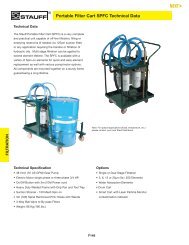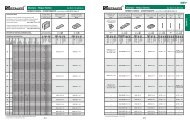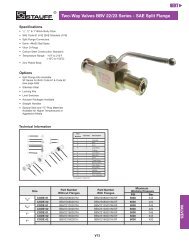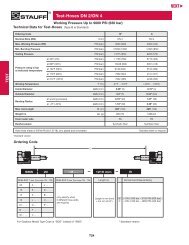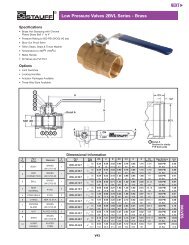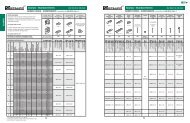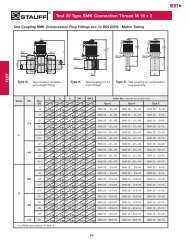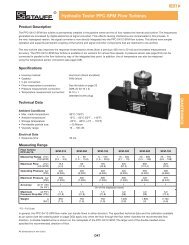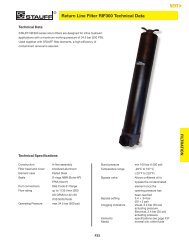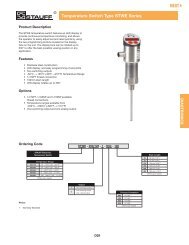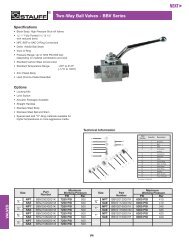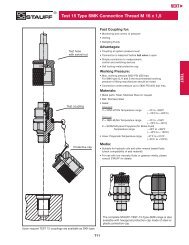Filtration Terminology
Filtration Terminology
Filtration Terminology
Create successful ePaper yourself
Turn your PDF publications into a flip-book with our unique Google optimized e-Paper software.
<strong>Filtration</strong> Guideline<br />
<strong>Filtration</strong> <strong>Terminology</strong><br />
ß-value<br />
The ß-value as per ISO 16889 is the relevant characteristic value for filtration efficiency.<br />
The ß-value is the ratio of particles before (N up x ) and after (N down x ) the filter related to<br />
a specific particle size x.<br />
Cavitation Damage<br />
ß x<br />
= N up x (see page C11)<br />
N down x<br />
Cavitation is defined to be the cavity formation in liquids. Cavitation occurs if the<br />
local static pressure of a liquid drops below a critical value. This critical value usually<br />
corresponds to the vapour pressure of the liquid. Critical effects of cavitation are:<br />
• Cavitation wear<br />
• Undissolved gas in the hydraulic system<br />
• Loud high-frequency noises<br />
• Local high temperatures in the liquid<br />
• Changes to the resistance characteristics of the hydraulic resistance<br />
Cleanliness Level<br />
The cleanliness level of a hydraulic fluid is defined by the number of solid particles per ml<br />
of fluid. The number of particles is usually measured with an automatic particle counter.<br />
The cleanliness level is determined by a class code created by counting the number of<br />
particles of different sizes.<br />
Particle counting as well as the coding of the cleanliness class for hydraulic oils are<br />
described in the ISO 4406 (1999) standard. Beside the ISO 4406 (1999), NAS 1638 (1964)<br />
and SAE AS4059 Rev. D (2001) are also still common.<br />
Clogging Indicator<br />
The clogging indicator signalises a specific pressure level where the soiled filter element<br />
should be replaced. They work with differential pressure (Δp) or back pressure. Clogging<br />
indicators are available in visual, electrical and visual/electrical versions. While it is the<br />
responsibility of the installation or maintenance personnel to check the degree of clogging<br />
of the filter element with visual clogging indicators, a signal contact (switch) can be<br />
connected to the machine controller with an electrical or visual/electrical clogging indicator.<br />
Collapse Pressure<br />
The permissible collapse pressure according to ISO 2941 is understood to be the<br />
pressure difference that a filter element can withstand with the stipulated direction of<br />
flow. Exceeding the collapse pressure results in the destruction of the filter element.<br />
Depth Filter<br />
Impurities penetrate into the filter fabric and are retained by the structure of the filter fabric.<br />
Mainly cellulose and inorganic glass fibre media are used in hydraulic filters. For special<br />
applications, plastic media (high-strength) and metal fibre media are also used. The design<br />
of the depth filter combines the highest micron rating with a high dirt retention capacity.<br />
Due to the fleece-like structure of depth filters, particles are not only separated on the<br />
surface of the filter material, but they can penetrate into the filter material, which leads to a<br />
considerable increase of the effective filter area. In contrast to sieves, there are no holes in<br />
fleece, rather they practically consist of labyrinths in which the particles are trapped.<br />
Hence, there is no sharply defined screening, rather a wide range of particles are trapped.<br />
Differential Pressure<br />
The differential pressure (Δp) is defined as the pressure difference between the filter inlet<br />
and the filter outlet, or alternatively in front of and behind the filter element.<br />
Exceeding the maximum permissible pressure differential leads to the destruction of the<br />
filter element.<br />
A bypass valve integrated in the filter prevents destruction of the filter element by opening if<br />
the differential pressure (Δp) is too high. Then the oil is passed unfiltered into the hydraulic<br />
circuit. For applications in which no unfiltered oil is allowed to pass into the hydraulic<br />
circuit, there is the possibility of using filters without bypass valves with filter elements that<br />
can withstand a high differential pressure (Δp). The filter elements must be designed such<br />
that they can withstand the maximum expected differential pressure (Δp).<br />
Dirt-Hold Capacity (DHC)<br />
The dirt-hold capacity (DHC) shows how much solid dirt a filter element can hold. It is measured<br />
in the multipass test according to ISO 16889<br />
EPDM<br />
Ethylene-Propylene-Diene-Monomer-rubber (EPDM) is used as a material for O-rings because<br />
of its chemical resistance.<br />
Filter<br />
A filter (hydraulic filter) has the job of keeping solids out of a liquid (oil). A filter is usually made<br />
of a filter housing and a filter element.<br />
Filter Area<br />
The filter area is the size of the theoretically spread-out filter element. The larger the filter<br />
area, the lower the flow resistance of the filter element. Simultaneously, the dirt-hold capacity<br />
(DHC) increases. The following applies in general: the larger the filter area, the longer the<br />
service life of the element. Basically the filter area can be enlarged by the number of pleats.<br />
Filter Cake<br />
A filter cake is made up of the particles trapped on the surface of a filter medium.<br />
Filter Design<br />
Essentially depends on the following factors: specific flow rate, cleanliness level, amount<br />
of contamination, the maximum pressure setting and the required filter service life.<br />
Filter Element<br />
The filter element is located in the filter housing and performs the actual filtering task.<br />
<strong>Filtration</strong> Efficiency<br />
<strong>Filtration</strong> efficiency is a measure of the effectiveness of a filter element for separating<br />
solid particles. It is given in percent (see page C11).<br />
Filter Housing<br />
Depending on the application, the filter housing is built into the pressure or return line and<br />
must be designed for the specific operating or system pressure and the flow rate. The filter<br />
element is located in the filter housing. Depending on the application, the filter housing may be<br />
equipped with a bypass valve, a reversing valve, a clogging indicator and other options.<br />
Filter Material<br />
The choice of the right filter material is dependent on different criteria. Amongst others, this<br />
includes the type of application, the filter function, degree of contamination or alternatively the<br />
required dirt-hold capacity (DHC) as well as requirements of chemical or physical resistance.<br />
The following list gives you an overview of how these filter materials differ with regard to<br />
specific properties:<br />
Inorganic Glass Fibre<br />
Inorganic Glass Fibre media are among the most important materials in modern filtration.<br />
During production, selected fibres (1 mm ... 5 mm long and with a diameter of 3 µm ... 10 µm)<br />
are processed into a specific mix. The manufacturing process is very similar to paper production.<br />
The fibres are bound with a resin and impregnated. The benefit compared to cellulose paper<br />
is a fibre structure that is considerably more homogenous and consequently has larger open<br />
pored surfaces. As a result, lower flow resistance is achieved.<br />
• Based on Glass Fibres with acrylic or epoxy resin binding<br />
• High retention and dirt-hold capacity (DHC)<br />
• Excellent separation efficiency of the finest particles due to the<br />
three-dimensional labyrinth structure with deepth filtration<br />
• Outstanding price/performance ratio<br />
C12<br />
www.stauff.com
<strong>Filtration</strong> Guideline<br />
Filter Material (Continuation)<br />
NBR (Buna-N®)<br />
Polyester<br />
• 100% Polyester Fibres with thermal bonding<br />
• High pressure differential resistance<br />
• Good chemical resistance<br />
• High separation efficiency of the finest particles<br />
• Tear-proof structure<br />
• No static charging<br />
Cellulose<br />
• Filter material made of Cellulose Fibres with special impregnation<br />
• Variants with the lowest price with good dirt retention capacity<br />
• Not suitable for water based media<br />
Metal Fibre<br />
• Sintered Metal Fibres with three-dimensional labyrinth structure for depth filtration<br />
• Low flow resistance with high dirt-hold capacity<br />
• Excellent chemical and thermal resistance<br />
Stainless Steel Wire Mesh<br />
Filter elements with a Metal Wire Mesh are often used as a conditionally reusable solution<br />
in protection filters, suction filters or return-line filters. Depending on the requirements<br />
(micron rating, pressure, dynamics) different types of mesh are used like twill, linen, or also<br />
Dutch weave.<br />
Nitrile rubber is the most commonly used elastomer for O-rings and other sealing devices.<br />
Also known as Buna N, Nitrile is a copolymer of Butadiene and Acrylonitrile (ACN). The name<br />
Buna N is derived from Butadiene and Natrium (the Latin name for Sodium, the catalyst used<br />
in polymerizing Butadiene). The “N” stands for Acrylonitrile.<br />
Nominal Flow Rate<br />
The nominal flow rate describes the flow rate or the volumetric flow rate for which the respective<br />
filter has been designed. It is usually given in litres per minute (l/min) or US Gallons per minute<br />
(US GPM) and is an important parameter in the filter design.<br />
Nominal Pressure<br />
Pressure for which the filter is designed and which it can be identified with.<br />
Operating Pressure / System Pressure<br />
Maximum pressure with which the filter may be used.<br />
Surface Filter<br />
Impurities are separated on the surface of the filter element. Surface filters are designed to<br />
have uniform pores (gaps), therefore they can almost completely retain specific particle sizes.<br />
Surface filters are made of Metal Wire Mesh or Cellulose materials.<br />
Other surface filters are metal-edge filters.<br />
Valve<br />
<strong>Filtration</strong><br />
C Technology<br />
• Wire mesh fabric made of material 1.4301 for surface filtration (other material on request)<br />
• Low flow resistance due to large-pored screening surface<br />
• Excellent chemical and thermal resistance<br />
• Cleanable<br />
Flow Rate<br />
This is the amount of fluid that flows past a specific cross-section per unit time. It is given<br />
in litres per minute (l/min) or gallons per minute (US GPM).<br />
FPM (Viton®)<br />
Fluorinated rubber is used as a material for O-rings and is characterised by its outstanding<br />
resistance to high temperatures, mineral oils, synthetic hydraulic fluids, fuels and chemicals.<br />
Hydraulic Fluid<br />
A pressure liquid is defined to be a fluid used in hydraulic and lubrication systems.<br />
According to ISO 6743, the fluids are divided into mineral oil based, flame resistant and<br />
biodegredable liquids.<br />
Micron Rating<br />
Regarding micron rating, we must differentiate between the filter materials that are used.<br />
To define the micron rating for Inorganic Glass Fibre filter elements, the ß-value as per<br />
ISO 16889 is commonly used.<br />
Multipass Test<br />
The Multipass Test evaluates the performance of a filter element. Standardised in<br />
ISO 16889-2008, this test allows comparable and repeatable results of the elements<br />
performance. If a normal filter element life is between a few weeks up to several months,<br />
this test reduces this life down to 90 minutes. The element is subjected to a fluid that a<br />
large amount of a special test dust ISO MTD contains. Results are given for the ß-ratio,<br />
dirt-hold capacity (DHC) and differential pressure. It is used for designing hydraulic circuits,<br />
developing new filter materials and comparison of different filter elements.<br />
See also page C10 and page C11 to get more information about the outcome data.<br />
In former time this test was also known as the Multipass Test ISO 4572.<br />
Bypass Valve<br />
A bypass valve is a valve that is integrated in a filter or filter element and allows the oil to<br />
bypass the contaminated filter element if a defined pressure differential is exceeded.<br />
Bypass valves are used to protect the filter element.<br />
Non-Return Valve<br />
It prevents the continuation line from draining while the filter element is changed.<br />
Reverse Flow Valve<br />
It is used to bypass the filter element for reversible oil flow so that the fluid does not pass<br />
through the filter element in the reverse direction.<br />
Multi-Function Valve<br />
A combination of bypass, reverse flow and non-return valve.<br />
Viscosity<br />
The viscosity of a fluid describes the flow behavior of a liquid. There are the kinematic<br />
viscosity υ with the unit “m²/s” and the dynamic viscosity h with the unit “Ns/m²”. In the<br />
field of filtration, in the design of filters the kinematic viscosity is required for calculating.<br />
The kinematic viscosity υ can also be calculated with the dynamic viscosity h and density ρ:<br />
υ = h<br />
ρ<br />
The kinematic viscosity unit is “mm²/s”, before it was called centistokes or Stokes<br />
(1 cSt = 1 mm²/s = 10 -6 m²/s). The unit of dynamic viscosity is “Ns/m², it was previously<br />
reported in Poise (10 P = 1 Ns/m² = 1 Pa s).<br />
www.stauff.com<br />
C13




